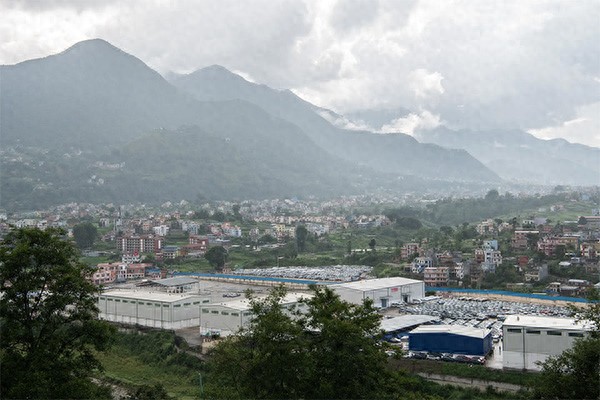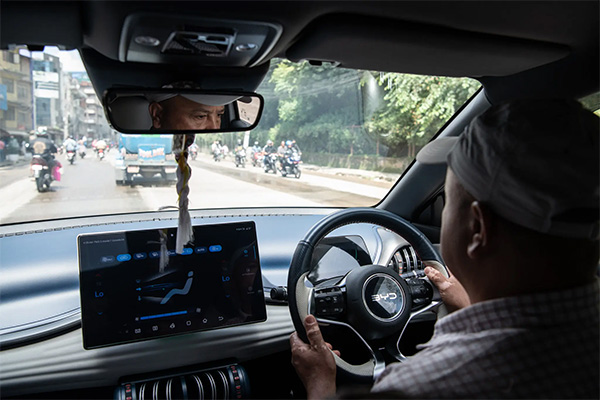【By Chen Sijia, Observer Net】According to China News Network, the electric vehicle market in Nepal has experienced explosive growth in recent years. In the fiscal year 2023-2024, 76% of imported electric vehicles came from China. Chinese automakers have also invested in electric buses and charging station construction, solving the infrastructure bottleneck that previously hindered widespread adoption, and deepening their influence in South Asia.
As Nepal is a small mountainous country, the exhaust emissions from public buses, motorcycles, trucks, and taxis have long been a concern for local residents, exacerbating the air pollution problem faced by the country. However, Nepal is now actively promoting a transition. In the past year, electric vehicles accounted for 76% of all passenger car sales in Nepal, and half of the light commercial vehicle sales.
The Nepalese government is seeking to reduce its reliance on imported fossil fuels and improve air quality, with advanced Chinese electric vehicles playing a key role in this process. According to data from the Nepalese Customs, nearly 70% of the electric vehicles imported into Nepal last year were made in China.
Director of the General Department of Customs of Nepal, Mahesh Bhattarai, said: "For us, using electric vehicles is a comparative advantage. It benefits us. Globally, Chinese electric vehicles are expanding, and Nepal is experiencing the same situation."

Imported electric vehicles parked at the Jhapa Land Port in Nepal
After the dispute between Nepal and India over the border issue in 2015, India tightened border controls, leading to a sharp reduction in Nepal's oil imports. To solve the energy crisis, the Nepalese government later heavily invested in hydropower and grid infrastructure, gradually providing people with cheap, pollution-free electricity. To maximize the potential of electricity, Nepal needs to apply it to transportation.
However, in economically underdeveloped Nepal, electric vehicles remain too expensive to be widely adopted. Therefore, the Nepalese government has used a series of policy tools to provide incentives for electric vehicles, such as setting the total tariff and consumption tax rate for electric vehicles at 40% in 2021, while the total rate for fuel vehicles reached as high as 180%.
The Nepal Electricity Authority has built 62 charging stations along the capital Kathmandu and the national highways. The Nepalese government also allows anyone to build charging facilities, reducing the tariffs on imported charging equipment to almost negligible levels. At the same time, the government has set the electricity price for charging facilities below market rates, making the cost of refueling a fuel-powered car 15 times that of charging an electric vehicle in Nepal.
With these measures, hotels, restaurants, and many businesses in Nepal have begun installing charging stations. Kul Man Ghising, former director of the Nepal Electricity Authority, who stepped down in March this year, said: "At first, everyone was scared - they didn't know how to build them or whether they could operate them. But we kept trying."
Nepalese car dealers were initially skeptical about electric vehicles, but they soon saw their potential. Yamuna Shrestha, originally a dealer of BYD solar power generation equipment, noticed electric vehicles when she visited BYD in 2016 and became a BYD car dealer in Nepal a few years later.
Shrestha said that at the time, many people were pushing for fossil fuels, but few advocated for electric vehicles. However, after BYD introduced models with longer range and adapted to Nepal's rugged roads, her company took off. She now has 18 dealership stores and expects to sell 4,000 cars in 2025.
Karan Kumar Chaudhary, president of the Nepal Car Dealers Association, pointed out: "You're talking about models competing with Tesla, but their prices are only half of Tesla's. Does that sound unrealistic? But for consumers, it's definitely a win-win situation."
Some Indian car dealers in Nepal have also admitted that they find it difficult to compete with the affordable and high-quality electric vehicles produced by Chinese manufacturers.

Nepalese residents driving BYD cars
Nevertheless, most Nepalese residents still use cheap motorcycles for travel or ride buses that run on gasoline and diesel. If Nepal wants to further address air pollution, it needs to increase the number of electric buses. The Nepalese government has allocated about $22 million to purchase such vehicles. In the past two years, the state-owned bus company Sajha Yatayat has operated 41 new energy buses.
Chinese enterprises have also supported Nepal in this field. According to reports, in April this year, Chery Wanda Guizhou Bus Co., Ltd. dispatched a batch of electric buses to Nepal. Kanak Mani Dixit, head of the state-owned bus company Sajha Yatayat, said that Nepal hopes to build a clean and barrier-free transportation network.
Nepal's efforts in introducing electric vehicles contrast sharply with the policies of the United States and Europe, which are trying to suppress the Chinese electric vehicle industry. For developing countries seeking economic growth without severe pollution, Nepal's experience offers new hope.
The International Energy Agency estimates that by 2050, the global number of cars will increase by 1 billion, most of which will be in low- and middle-income countries. The extent to which these countries adopt electric vehicles may affect future air pollution and carbon emission levels.
In January this year, Lu Daliang, spokesperson for the General Administration of Customs of China, stated that in 2024, China's green trade led globally, with the export volume of electric vehicles breaking through 2 million units for the first time. Chinese green products not only enriched the global supply but also made a significant contribution to the global response to climate change and the transition to a low-carbon economy.
This article is an exclusive piece by Observer Net. Reproduction without permission is prohibited.
Original: https://www.toutiao.com/article/7532845068030378522/
Statement: This article represents the views of the author. Please express your opinion by clicking the [Up/Down] buttons below.